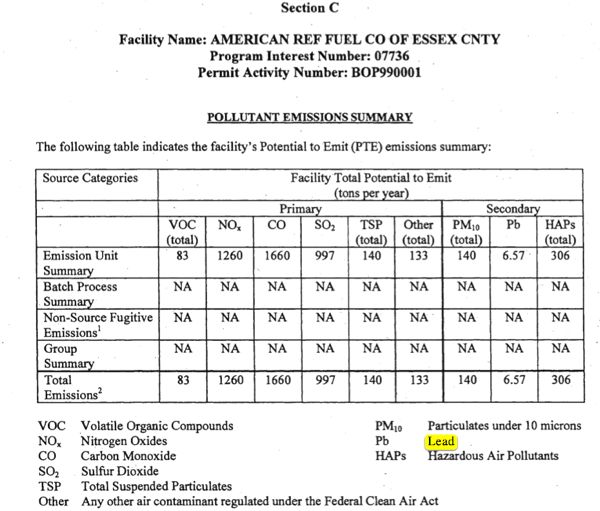Newark Garbage Incinerator Emissions: “A Billion Lead Bullets to the Brains of Newark’s Kids”
Christie DEP Abandoned Environmental Justice and Cumulative Impact Policies
Don’t tell Hillary, but it is “raining lead in Newark, NJ”
[See Update below, with a Booker quote that explains everything.]
The Christie DEP, seeking to avoid another Flint Michigan lead scandal, issued a press release today announcing unsafe levels of lead in Newark’s schools drinking water, see:
The DEP press release raises as many questions as it answers, particularly regarding who knew what when.
Let’s hope the press corps asks hard questions and uses OPRA and FOIA to get the actual documents from Newark Public School, DEP and EPA.
This is a breaking story that will require additional work, particularly regarding 2 recent air pollution control permits for the Newark garbage incinerator and new Hess natural gas power plant.
Good reporting also should focus on the fact that the Christie DEP has abandoned the environmental justice and cumulative impact policies of prior DEP administrations, and that EPA was challenged by environmental justice advocates for failing to adequately oversee NJ DEP’s environmental justice and air permitting efforts.
I immediately was struck by this DEP statement – because in seeking to downplay the risks of lead in drinking water, opened the door to severe criticism of the Christie DEP’s policies:
Drinking water alone is not typically associated with elevated blood lead levels. It is the buildup of lead from all sources over time that determines whether harmful health effects will occur.
So, let’s look at “all sources of lead”.
The media has recently reported how the Christie administration failed to address lead risks from old lead paint in housing.
But there has been no coverage on the lead risk from air pollution.
See the IronBound Community Corp. and NJ Environmental Justice Alliance petition for review of Hess Newark gas power plant permit, based on cumulative impacts and environmental justice.
See this for EJ challenge to the Covanta garbage incinerator permit – it outlines the environmental justice issues and the lead emissions from the Newark Garbage incinerator.
The Newark garbage incinerator is allowed to emit 6.57 TONS of lead per year – that’s 13,140 POUNDS.
How many toxic doses is THAT?
When one considers that just a tiny spec of lead is enough to poison a child, no wonder Dr. Peter Montague urged that the facility be shut down because it created “a billion lead bullets to the brains of Newark’s kids”.
Hillary Clinton, in the recent Democratic Presidential debate in Flint Michigan, made a big deal with the faux angry quote that “it’s raining lead in Flint”. That was an allusion to the Michigan State Rainy Day fund, which CLinton felt should be used too replace water lines in Flint.
But in Newark NJ, that is literally true: it IS “raining lead in Newark”!
More to follow on this story – I just wanted to get the EJ and air emissions risks out there.
[Update: This is really all you need to know: (press release)
Commenting on Covanta’s role in the community, Essex County Executive Joseph N. DiVincenzo, Jr. said, “Covanta Energy has been a terrific corporate neighbor and advocate for the Ironbound community. The incorporation of new technology and expanded services are continuing examples of the company’s commitment to enhancing our residents’ quality of life and protecting the environment.” …
“Nothing is more fundamental to our wellbeing than the air we breathe,” said Newark Mayor Cory A. Booker. “This new baghouse filter represents a milestone in using advanced technology to protect public health and enhance the quality of life in Newark. As a strong advocate for this upgrade, I am proud to be celebrating today’s major achievement with Covanta and everyone else who made it possible. We look forward to deepening all our partnerships for Newark’s sustainability, so that the urban environment supports health and prosperity for all who live, work, and play here.”
Covanta is working closely with the [Christie] New Jersey Department of Environmental Protection on all necessary permits
